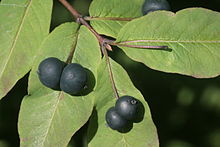Black honeysuckle
| Black honeysuckle | ||||||||||||
|---|---|---|---|---|---|---|---|---|---|---|---|---|

Black honeysuckle ( Lonicera nigra ), illustration |
||||||||||||
| Systematics | ||||||||||||
|
||||||||||||
| Scientific name | ||||||||||||
| Lonicera nigra | ||||||||||||
| L. |
The black honeysuckle ( Lonicera nigra ) is a shrub from the honeysuckle family (Caprifoliaceae). The name refers to the black fruits.
features
The black honeysuckle is an upright shrub with stems that do not twist. It reaches a height of 50 to 200 centimeters. The branches are dark brown, bare or almost bare, slender and smooth. They have a white pith that is pentagonal in cross-section. The buds are egg-shaped and pointed. They are up to seven millimeters long, glabrous and have dendrods in their armpits. The bud scales are pointed, have a keel and are brown with gray peeling epidermis.
The leaves are up to nine centimeters long and have an ovoid-elliptical leaf shape . The leaf base is broadly wedge-shaped, the tip of the leaf pointed or blunt. They are only sparsely hairy or completely bald on the underside of the veins. The upper side of the leaf is vivid green, the underside lighter, gray-green. The petiole is up to five millimeters long.
The flowers stand in pairs on a common stalk that arises in a leaf axil. The stem is three to four times as long as the flowers. The overgrown calyx has five pointed, glandular hairy teeth. The corolla is reddish or white and eight to ten millimeters long. The corolla tube is short, the longer hem is two-lipped: the upper lip is erect and divided into four, the lower lip is narrow and bent back. There are five stamens . The ovaries of a pair of flowers are only fused together at the base. The pen with capitate stigma is not enough as the stamens beyond the crown. The flowering period is from April to June. Bees are responsible for pollination .
The fruits are black double berries with a blue rime. They are eight to ten millimeters in diameter and ripen in July / August. A berry contains two flat, elliptical seeds four millimeters long. It is spread by birds. Some of the berries are poisonous and some are inedible.
The number of chromosomes is 2n = 18.
Occurrence
The species occurs only in the mountainous regions of southern, central and eastern Europe. It originally occurs in Spain, Andorra, France, Germany, Switzerland, Liechtenstein, Austria, the Czech Republic, Slovakia, Poland, Hungary, Italy, Slovenia, Croatia, Serbia, Montenegro, Bosnia-Herzegovina, Bulgaria, Greece, Romania, Ukraine . In Norway she is a neophyte. The northern border in Germany are Rhön , Franconian Forest , Thuringian Forest , furthermore Fichtelgebirge and Upper Lusatia . The eastern border is the Carpathian Arc . In the west it occurs like islands in parts of the Pyrenees , in the Cevennes , Vosges and in the southern Black Forest . In the south it occurs in the northern Apennines , in the south-east to northern Greece. It is absent in the Po Valley and the Hungarian Plain within the area.
It occurs in the montane to subalpine altitude range . In the Bavarian Alps it rises up to 1460 m, in Tyrol up to 1900 m and in Graubünden up to 2000 m. In the Allgäu Alps, it rises in Bavaria on the Häbelesgrund between Breitenberg and Rotspitze up to 1600 m above sea level.
It prefers sub-oceanic climates and grows in the mixed mountain forests under spruce, fir and beech, but also in green alder bushes and in mountain pine stands. Its main distribution area in Central Europe is in Abies forests of the Galio Abietenion sub-group, but also occurs in high-montane Fagion forests, in herb-rich Piceieon forests and, more rarely, in societies of the Prunetalia or the Calamagrostion arundinaceae group.
The black honeysuckle grows mainly on fresh, moderately nutrient-rich, rather lime-poor soils.
ecology
She is a shade plant . Its flowers are pollinated by insects, especially bees.
literature
The article is based on the following literature:
- Peter Schütt, Ulla M. Lang: Lonicera nigra . In: Schütt, Weisgerber, Schuck, Lang, Stimm, Roloff: Encyclopedia of Bushes . Nikol, Hamburg 2006, pp. 193–196. ISBN 978-3-937872-40-7
- Siegmund Seybold (Ed.): Schmeil-Fitschen interactive (CD-Rom), Quelle & Meyer, Wiebelsheim 2001/2002, ISBN 3-494-01327-6
Individual evidence
- ↑ a b c Erich Oberdorfer : Plant-sociological excursion flora for Germany and neighboring areas . 8th edition. Stuttgart, Verlag Eugen Ulmer, 2001. Pages 877-878. ISBN 3-8001-3131-5
- ↑ a b E. von Raab-Straube (2017+): Caprifoliaceae. - In: Euro + Med Plantbase - the information resource for Euro-Mediterranean plant diversity. Datasheet Caprifoliaceae
- ↑ Erhard Dörr, Wolfgang Lippert : Flora of the Allgäu and its surroundings. Volume 2, IHW, Eching 2004, ISBN 3-930167-61-1 , p. 522.
Web links
- Black honeysuckle. In: FloraWeb.de.
- Black honeysuckle . In: BiolFlor, the database of biological-ecological characteristics of the flora of Germany.
- Profile and distribution map for Bavaria . In: Botanical Information Hub of Bavaria .
- Lonicera nigra L. In: Info Flora , the national data and information center for Swiss flora . Retrieved March 30, 2016.
- Thomas Meyer: Honeysuckle data sheet with identification key and photos at Flora-de: Flora von Deutschland (old name of the website: Flowers in Swabia )

